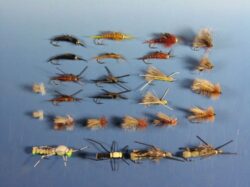 Stoneflies are amazing flies to try. They are available year around and are a prized food source for trout, bass, and other fish. Large Stones are called “Salmon Flies”. They are the Big Mac of the bug world. These fat flies make for a great meal. When they emerge to reproduce, fish feed on them voraciously.
Stoneflies are amazing flies to try. They are available year around and are a prized food source for trout, bass, and other fish. Large Stones are called “Salmon Flies”. They are the Big Mac of the bug world. These fat flies make for a great meal. When they emerge to reproduce, fish feed on them voraciously.
June is Stonefly time in Montana and many western waters. The hatch emerges from the west and travels eastward as the water temperatures, 50 -55 degrees, dictate their emergence. When mating begins, Salmon flies leave the security of the river and crawl onto the shore. After crawling out of their exoskeleton shucks, they allow their wings to form and dry, then it’s time to take off.
In Montana, Rock Creek happens first around the first week of June. The Madison River begins around June 20th. The Yellowstone is a bit later and lasts into July. Hatches begin lower in the watersheds and work upstream. This hatch brings hoards of anglers to the water. They tend to gang up in drifts where the hatch is peak. Try above and below the crowds for less of a Circus.
Stones are not the best fliers. Many crash back into the water where they become dinner for the fish. Birds, snakes, rodents, and fish feast on this Stone bounty.
Fishing the hatch begins using large stone nymphs. Dry flies are next. There is then a lull in the feeding as full fish need a few days to digest their meals. Then the hatch seems to ignite again. Other hatches are also going on during this hatch, so fish are not as picky, fat, and happy.
There are a ton of Stonefly/Salmon fly patterns available. Many are pricey or difficult to tie. Some are more and less durable. Others float all day and some sink like a rock. So, what is the best Stone Fly nymph to use?
Foam Flies
I am not a big fan of foam. They look great and float well, but many are tired on a straight streamer hook. This allows them to roll on the hook. Even if you use a popper style, long shanked hook, the foam will roll and tear. They have great names like the Rogue Foam, Chubby Chernobyl, Dancing Ricky, and many more. After a few fish, the fly becomes less productive. Remember that many of the fish feeding on big flies are also BIG. Big Brown trout have big teeth and quickly destroy foam. Most foam is also not degradable and like other plastics ware forever chemicals/trash.
Hair Flies
Back in the day we used simple patterns like the Spruce Fly, tied on a streamer hook. If you used proper flotant, the patterns were long lasting and floated well. You would need to change them after several fish and allow them to dry on your fish patch. These patterns were often lightweights and did not flop onto the water.
A beefier fly impacts the water more like a natural. I like stones that have some mass. The sound and vibration will attract the fish from feet away. This is the way I prefer my hoppers to be as well. The heavier Stonefly patterns with more hair and bucktail do well, even after getting torn up a bit.
Nymphs
Stone nymphs are also a great fly to use. Nymphs will migrate near the shores prior to the hatch. Dozens of 2–3-inch black nymphs can be found under shoreline rocks and logs. These nymphs are also good to eat. Stir fry some butter with a pinch of salt. Toss some in your mouth raw as well. They tasted like pea pods and were often a food source for native peoples.
The Brown or Black rubber legs nymph is my favorite. The rubber legs mimic movement and the flies are bulletproof. They need to be fished along the bottom, so you tie the fly weighted. A no weight fly works as an effective dropper off an adult salmon fly pattern.
I often use a smaller dropper with my Dry-Stone patterns. A sized 12-14 PMD or Caddis nymph will also work. Attractor nymphs like a Prince or Lightening bug will also work. You will often see a strike on the surface fly and discover that the fish is hooked on the nymph.
My favorite time to use Salmon flies is at first and last light. Timing is critical. This is also when most guided parties have either not arrived from breakfast or have left for dinner. Windy and rainy days are poorer fishing since the bugs can’t stay airborne. An overcast, still day is my favorite. I enjoy fishing in front of the hatch a mile or so or behind the hatch. Crowded waters are just too crowded, and people can show rude and greedy behaviors. I have done on Salmon Flies weeks after the main hatch, once the crowds have left. Also use polaroid glasses to see the fish and stealth fully stalk them.
Handle the fish with care. Big fish fight longer and harder. Any fish fighting longer than 3 -4 minutes will die from exhaustion. Lactic acid builds up in their bodies and it takes time for them to recover and feed again. Weak and injured fish are easy prey for raptors, pelicans, and … Research and practice ethical Catch and Release skills.
Rock On!
Montana Grant
